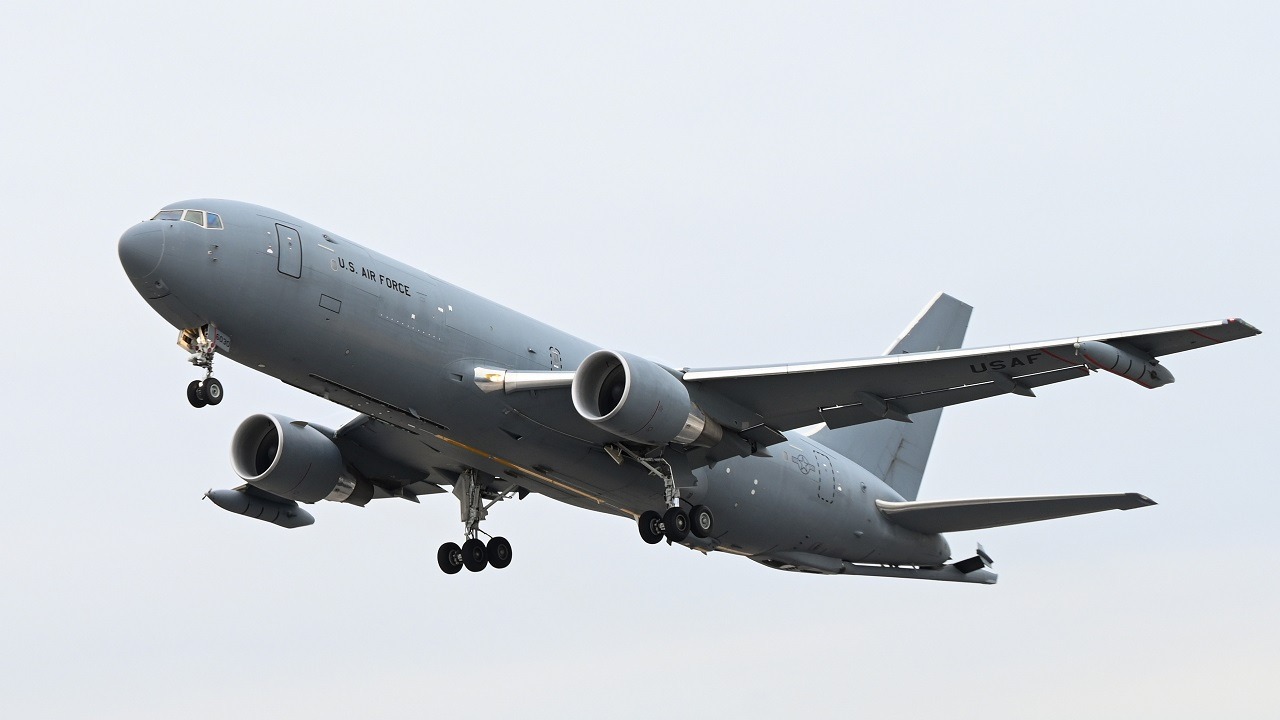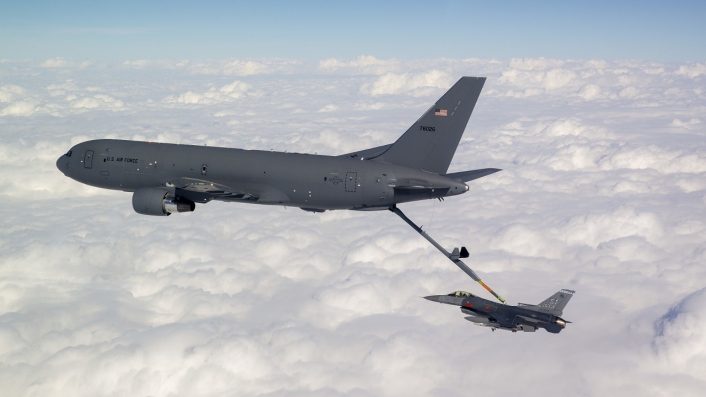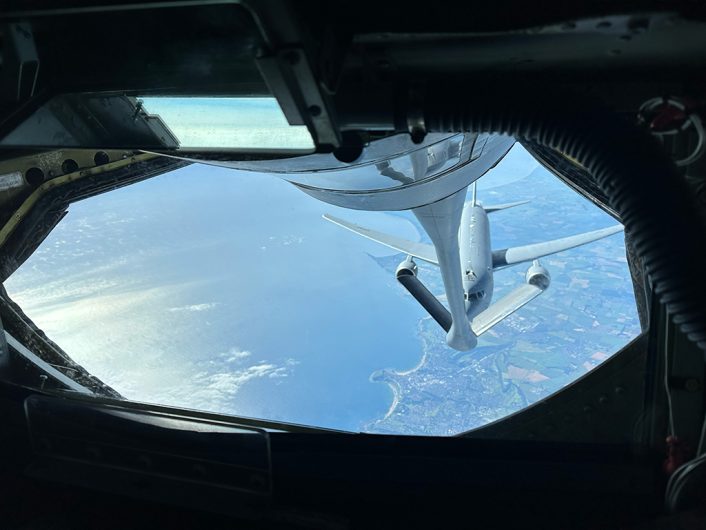Italian Air Force Suspends 1.2 Billion Euro KC-46 Program


The service communicated last week to the Ministry of Defense the decision to halt the replacement of the current KC-767 tanker fleet with the new KC-46 Pegasus.
The Italian Air Force has unexpectedly decided to halt the acquisition, announced in 2022, of the KC-46 Pegasus. In fact, the service has communicated the decision to the Ministry of Defense last week, on Jun. 24, 2024, attributing it to “changed and unforeseen needs,” without adding further details.
In the last few years, Italy committed to many important investments towards the modernization of its armed forces. In fact, as mentioned by the MoD, the changed perception of security and defense in Europe, which emphasized the increasing strategic global competition, resulted in a renovated attention to the modernization of armed forces.
The 767s are among the most in-demand assets of the Italian Air Force: while their primary role is AAR (Air-to-Air Refueling), the KC-767A, in both Cargo, Combi and Full Pax configurations, can be used for strategic transport missions as well as MEDEVAC (Medical Evacuation) or Bio-Containment missions. According to a report from Lt. Gen. Enrico Degni, the service’s air mobility and support forces commander, the fleet usage is split as 49% for AAR, 28% passenger and 23% cargo.
Since their induction in service in 2011, the KC-767s have been very busy supporting all the various Italian real operations and deployments around the world. With more than 30,000 flight hours since they entered active service (a milestone achieved in 2020), the KC-767 fleet has proved to be a force multiplier not only for the Italian MOD but also for NATO, as they are also assigned to the EATC (European Air Transport Command).
Thus, considering the tankers’ intense activity, it is not clear what the “changed and unforeseen needs” might be and if they are strictly related to the tanker itself or to other priorities of the ItAF. Also, it is unclear if the cancellation will be definitive or just postponed, as the final part of the note sent to the MoD mentions the previous acquisition request being cancelled while waiting for a new mandate from the Air Force General Staff.
Let’s not forget that Italy would have been the only European operator of the US-made tanker, as France, Spain and the U.K. acquired the A330 MRTT (Multi-Role Tanker Transport), while Belgium, Czech Republic, Germany, Luxembourg, Norway and the Netherlands share the A330 MRTT tankers of the NATO MMF (Multinational MRTT Fleet).

The Italian KC-46 acquisition
In 2022, the Italian Air Force launched the program for the “Renewal, strengthening and Integrated Logistic Support of the Italian Air Force Heavy Multirole Tanker fleet”, worth over € 1.2 billion. The service already has four KC-767A tankers in service, but had the intention to increase the fleet by 50%, bringing the total to six aircraft.
The plan initially announced, part of the multiyear defense planning document for 2022-2024, was to acquire two new KC-46 tankers and upgrade the current four KC-767A tankers to the same standard. According to the program’s preliminary report, the original plan was instead to procure two new KC-767A airframes and upgrade both these and the existing four ones to the latest configuration standard (KC-46A), but it was found not feasible.
The commission which evaluated the project found as the only viable solution the acquisition of six new aircraft already at the same standard currently in service with the U.S. Air Force (which the document called KC-767B). The project also planned to include a contract clause under which Boeing would have bought back the KC-767As, as they are expected to be retired by 2035.
The KC-767As, ordered in 2002 and delivered between 2011 and 2012, are part of a very small global fleet, with Japan being the only other operator. This resulted in a high cost of ownership and increasing obsolescence issues, and that’s why it was decided to get the aircraft in the same configuration as the U.S. Air Force.
The Italian Parliament reportedly already approved in 2023 the decision, part of the original plan, to acquire two new KC-767As to be later converted to the KC-767B configuration.
The KC-767A
Based on the commercial B767-200ER (Extended Range), the KC-767A is equipped with both the sixth generation flying boom (similar to the one of the American KC-10), and three hose and drogue stations (WARPs – Wing Air Refueling Pods). This dual capability gives the KC-767A a significant flexibility: during the same mission the tanker can refuel both aircraft equipped with onboard receptacle and those with an IFR (In-Flight Refueling) probe.
The tanker is itself equipped with a receptacle, meaning that it can be refueled by another KC-767 extending its range (or on-station time). The aircrews of the 8° Gruppo are also capable of “buddy refueling operations”: a KC-767 can refuel another KC-767 mid-air using the flying boom and the aircraft’s receptacle, further extending the aircraft endurance.
Unlike the “legacy” refuelers, as the U.S. Air Force KC-135 Stratotanker, where the “boomer” (as the operator of the boom is nicknamed) watches the receiver through a rear observation window, in the KC-767 the ARO (Air Refueling Operator) move the boom using a joystick while watching the video coming from a series of cameras mounted on the tanker’s rear fuselage. The advanced camera system feeds a Remote Vision System (RVS) that provides high-definition stereoscopic imagery to the vision goggles attached to a sort-of flight helmet worn by the boomer during the air-to-air refueling.
The KC-46A Pegasus
While a Boeing 767 derivative too, the KC-46A Pegasus the U.S. Air Force selected to replace the older KC-135 features a stretched fuselage, different engines, cockpit, wings and boom: in other words, it’s almost a completely different tanker. One of the main differences that makes it stand out compared to previous USAF tankers is the absence of a rear-facing window for the refueling boom operator, replaced by a camera system.
The KC-46 was born from the KC-X program, for which Boeing submitted its KC-767 tanker proposal in 2007. The aircraft, however, was based on the in-development 767-200LRF (Long Range Freighter), rather than the -200ER, differing by combining the -200ER fuselage, -300F wing, gear, cargo door and floor, -400ER digital flightdeck and flaps, upgraded engines and “sixth-generation” fly-by-wire boom.
Boeing proposal was selected as the winning one in 2011 and received the designation KC-46A, with the first flight in 2015. Since then, the program has been plagued by deficiencies which required redesigns, causing delays and over $7 billion charges incurred by Boeing.

As of Jan. 2024, the KC-46 has six category 1 deficiencies, which could cause loss of an aircraft, injury, or death, according to the Air Force classification. Work is ongoing to fix them once for all.
The first, possibly the most important, is related to the cameras which replaced the boom operator’s window. There are two groups of cameras: the Remote Vision System (RVS), which focuses on the boom, and a second group which provides a panoramic view to the rear of the tanker. Both systems struggle under certain environmental conditions and Boeing is working on an RVS 2.0, expected in late 2025.
Another problem is related to the boom, and specifically an actuator inside the boom which prevents the A-10C to be refueled. In fact, the A-10 can’t generate enough force to stay connected to the boom due to its low speed, so the hydraulic actuator provides that force to keep the boom rod in the receptacle. A new actuator is expected by 2026.
Then, there are product quality issues, which involve three separate parts of the aircraft: drain masts for its auxiliary power unit (APU), a seal for its fuel manifold and a drain line that runs near the cockpit. Specifically, the APU’s drain masts showed a tendency to crack, solved with additional reinforcements.

The fuel manifold, which runs 555 feet throughout the plane, is fitted with flex couplings throughout so that it can bend in flight. Incorrect positioning of the coupling’s seals enabled fuel to seep out of the inner tube into the outer one, so Boeing implemented a new flex seal.
The last one was related to the AAR receptacle on top of the cockpit, specifically the receptacle drain line, which empties liquid out but is at risk of cracking and could cause fuel to leak into the cockpit. A fix has been found and should be implemented by next year.
Adding to this, there is another problem with a key feature, the Wing Aerial Refueling Pods. The WARPs, mounted on the aircraft’s wings, are designed to refuel two aircraft simultaneously, however the Director of Operational Test & Evaluation’s 2023 annual report mentioned the pods did not yet enter Initial Operational Test & Evaluation (IOT&E) because they didn’t achieve the FAA supplemental-type certification.
Specifically, the WARPs did not meet certification requirements for cowling bird strike, lightning tolerance, and wiring corrosion protection. The Air Force stated that certification is ongoing and IOT&E should start this year.

